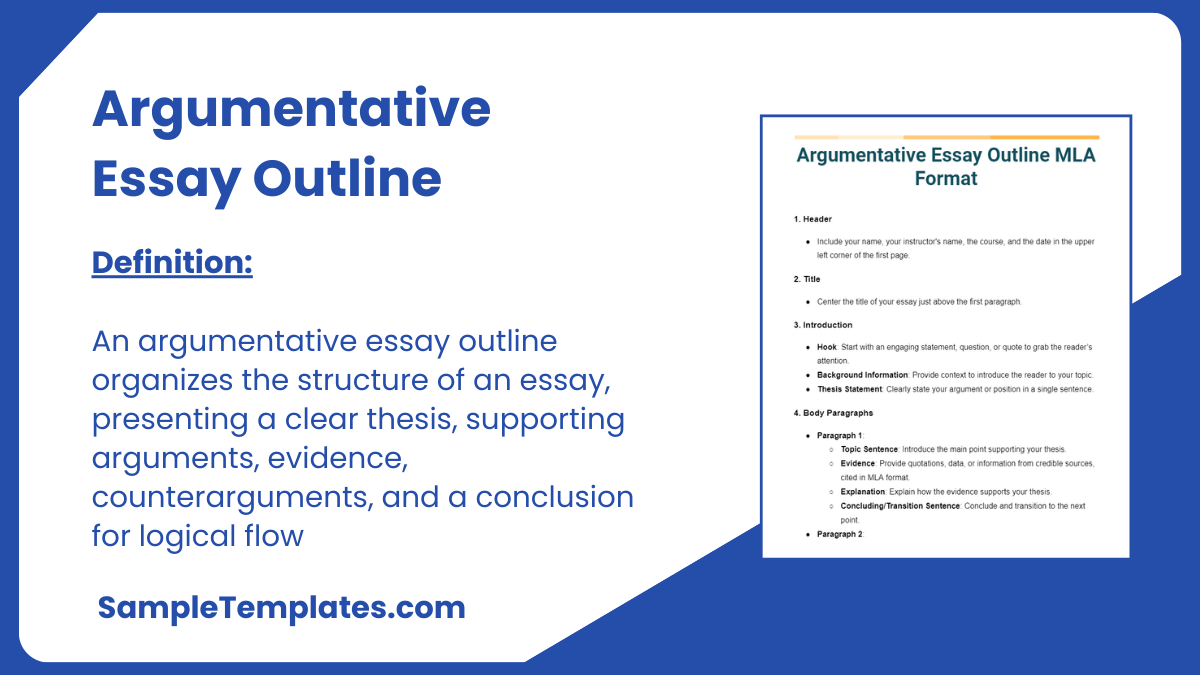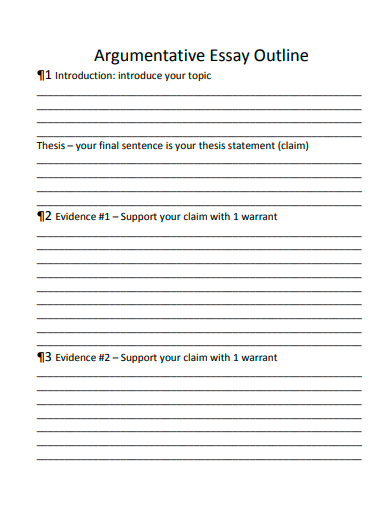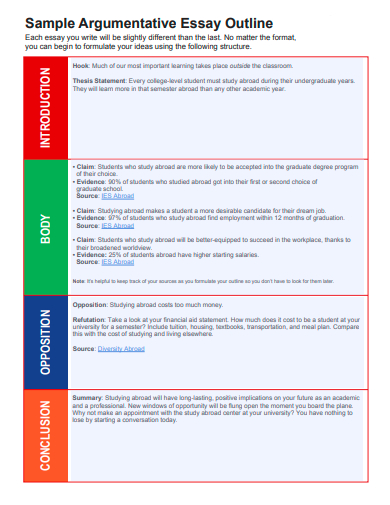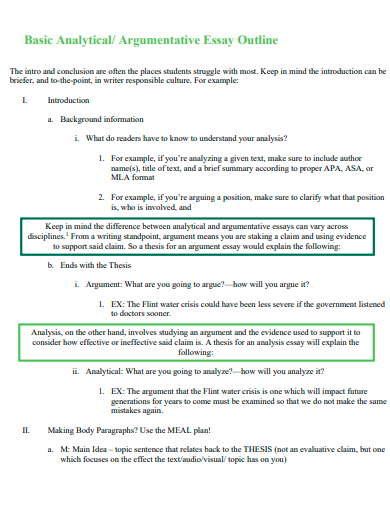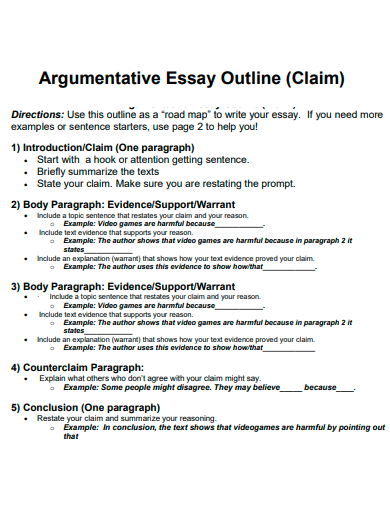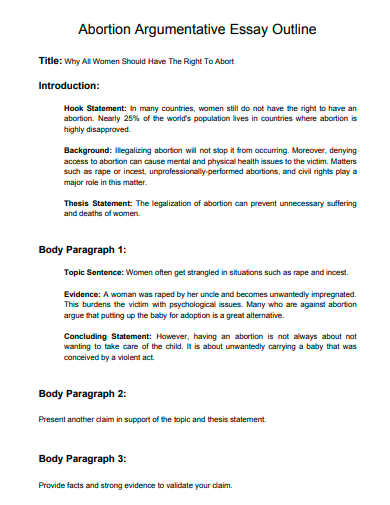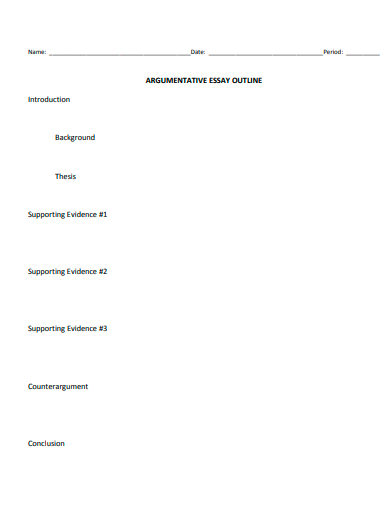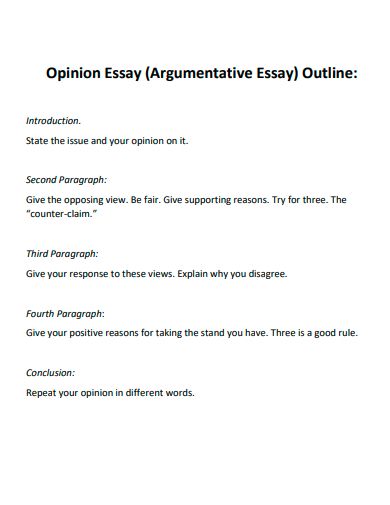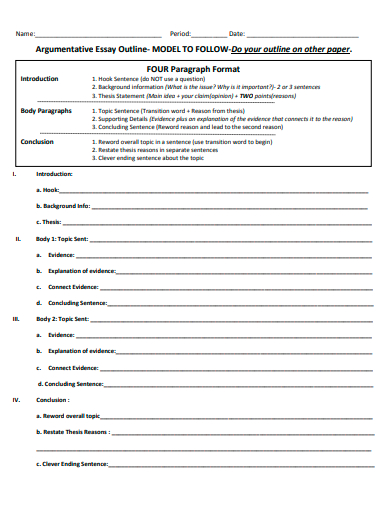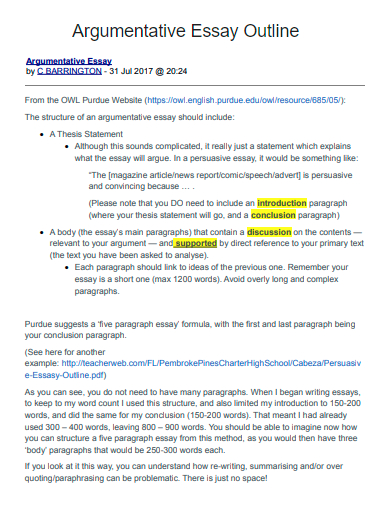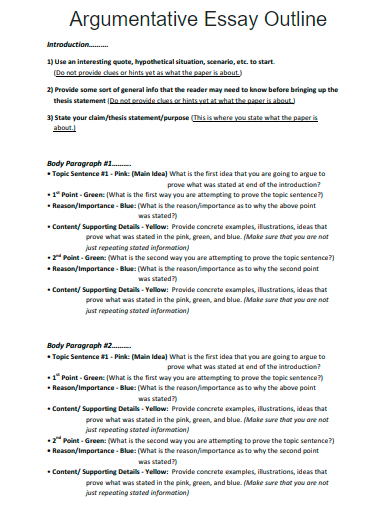An argumentative essay is a type of professional writing that requires the writer to investigate a topic by collecting, generating, and evaluating evidence as well as establishing a position on the topic in a clear manner. It requires extensive research of literature or material published before the time of writing the essay, in which data is collected by interviewing, surveying, observing, and experimenting. By doing this, a student is able to understand and learn more about the different points of their topic while supporting it with credible pieces of evidence.
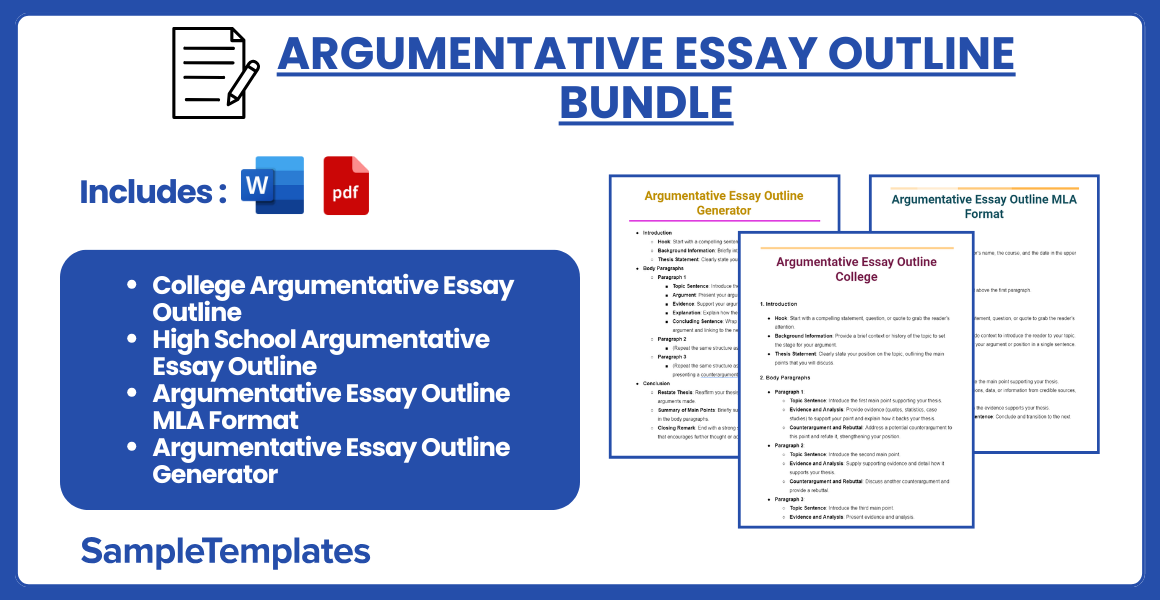
Download Argumentative Essay Outline Bundle
College Argumentative Essay Outline
1. Introduction
- Hook: Start with a compelling statement, question, or quote to grab the reader’s attention.
- Background Information: Provide a brief context or history of the topic to set the stage for your argument.
- Thesis Statement: Clearly state your position on the topic, outlining the main points that you will discuss.
2. Body Paragraphs
- Paragraph 1:
- Topic Sentence: Introduce the first main point supporting your thesis.
- Evidence and Analysis: Provide evidence (quotes, statistics, case studies) to support your point and explain how it backs your thesis.
- Counterargument and Rebuttal: Address a potential counterargument to this point and refute it, strengthening your position.
- Paragraph 2:
- Topic Sentence: Introduce the second main point.
- Evidence and Analysis: Supply supporting evidence and detail how it supports your thesis.
- Counterargument and Rebuttal: Discuss another counterargument and provide a rebuttal.
- Paragraph 3:
- Topic Sentence: Introduce the third main point.
- Evidence and Analysis: Present evidence and analysis.
- Counterargument and Rebuttal: Counter and refute another opposing view.
3. Additional Body Paragraphs (if necessary)
- Follow the same structure as previous paragraphs to address more points.
4. Conclusion
- Summary of Main Points: Briefly recap the main points you have made in your body paragraphs.
- Restatement of Thesis: Restate your thesis in a new way, reinforcing your argument.
- Call to Action or Closing Thought: End with a call to action or a thoughtful concluding remark to leave a lasting impression on the reader.
5. References
- List all the sources cited in your essay in the appropriate format (APA, MLA, Chicago, etc.).
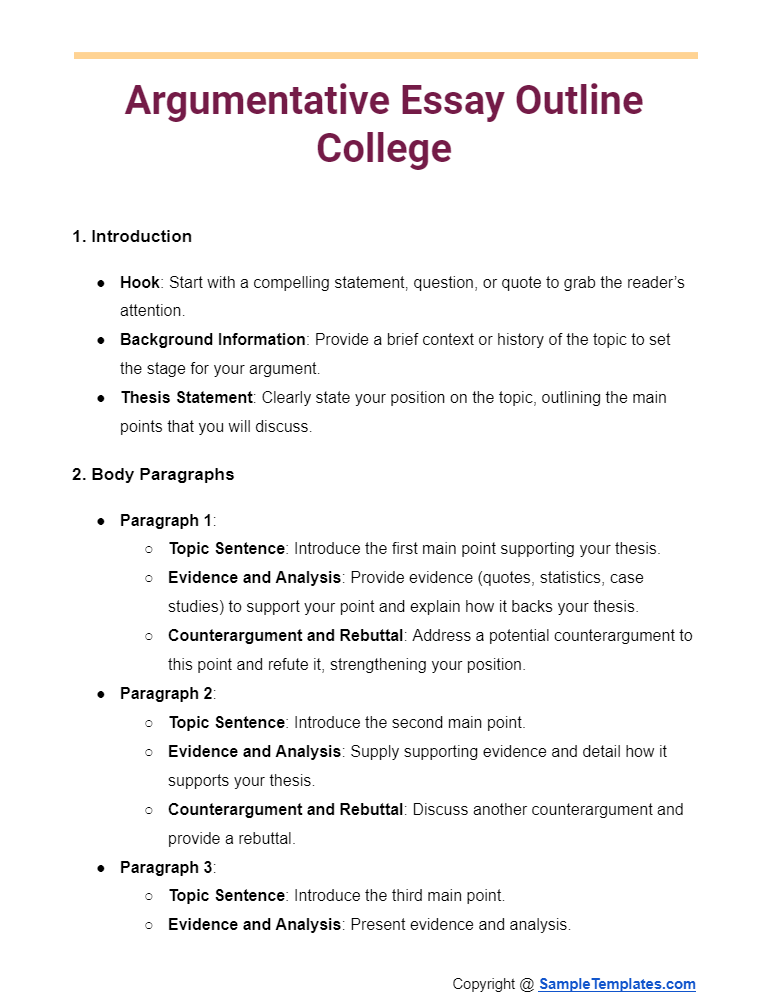
High School Argumentative Essay Outline
1. Introduction
- Hook: Begin with an engaging sentence to capture the reader’s interest, such as a surprising statistic: “Did you know that less than 10% of plastics are recycled globally?”
- Background Information: Briefly introduce the topic to give context and background that will help the reader understand the issue, e.g., the impact of plastic pollution on the environment.
- Thesis Statement: Clearly state your main argument or position in one sentence, such as “Governments should mandate stricter plastic recycling laws to combat environmental pollution.”
2. Body Paragraphs
- Paragraph 1:
- Topic Sentence: Start with a sentence that introduces the first main point of your argument, like “Mandatory recycling laws can significantly reduce plastic waste.”
- Evidence: Provide facts, quotes, statistics, or examples that support your main point, such as data from recent studies showing reduction rates in plastic waste due to strict regulations.
- Explanation: Explain how this evidence supports your thesis.
- Concluding Sentence: Wrap up this paragraph by reinforcing how the evidence and point support your thesis.
- Paragraph 2:
- Topic Sentence: Introduce the second main point, for instance, “Strict recycling laws also promote technological innovation in waste management.”
- Evidence: Provide supporting evidence, such as examples of new recycling technologies developed in countries with stringent regulations.
- Explanation: Describe how this supports your thesis.
- Concluding Sentence: Summarize the paragraph and reinforce its relevance to your thesis.
- Paragraph 3:
- Topic Sentence: Start with your third main point, like “Effective recycling laws foster greater public awareness and participation in environmental conservation.”
- Evidence: Supply evidence to back up this point, such as surveys showing increased public engagement in recycling initiatives.
- Explanation: Explain the significance of this evidence.
- Concluding Sentence: Conclude the paragraph by tying the point back to your thesis.
- Counterargument Paragraph (optional but recommended):
- Topic Sentence: Introduce a counterargument, such as “Some argue that mandatory recycling laws are too expensive for governments to enforce.”
- Evidence and Explanation: Present evidence and explain the counterargument, using financial data or quotes from critics.
- Rebuttal: Argue against the counterargument and show why your original thesis is stronger, perhaps by discussing long-term savings and environmental benefits.
3. Conclusion
- Summary of Arguments: Briefly recap the main points you have made in the body paragraphs.
- Restatement of Thesis: Reinforce your thesis, now that you have backed it up with arguments.
- Final Thought: End with a strong closing statement. This could be a call to action, a quote, or a rhetorical question to leave the reader thinking, like “Isn’t it worth investing in our planet’s future?”
4. References
- List all the sources cited in your essay in the appropriate format, such as MLA or APA.
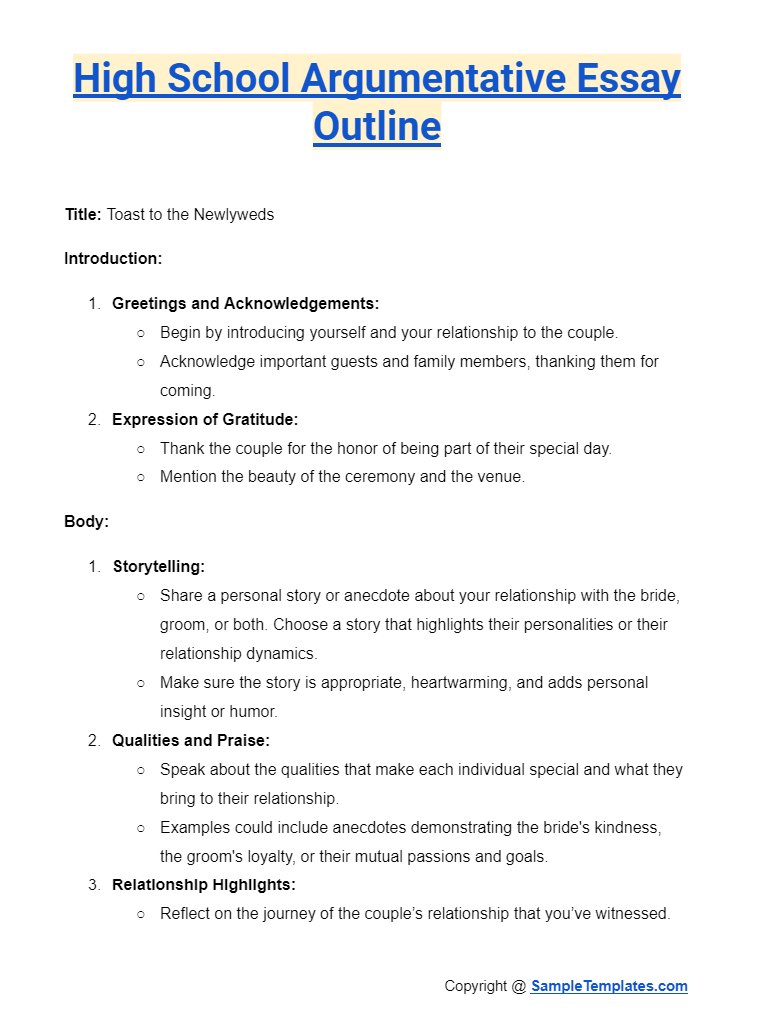
Argumentative Essay Outline MLA Format
1. Header
- Include your name, your instructor’s name, the course, and the date in the upper left corner of the first page.
2. Title
- Center the title of your essay just above the first paragraph.
3. Introduction
- Hook: Start with an engaging statement, question, or quote to grab the reader’s attention.
- Background Information: Provide context to introduce the reader to your topic.
- Thesis Statement: Clearly state your argument or position in a single sentence.
4. Body Paragraphs
- Paragraph 1:
- Topic Sentence: Introduce the main point supporting your thesis.
- Evidence: Provide quotations, data, or information from credible sources, cited in MLA format.
- Explanation: Explain how the evidence supports your thesis.
- Concluding/Transition Sentence: Conclude and transition to the next point.
- Paragraph 2:
- Topic Sentence: Outline the second point.
- Evidence: Provide more evidence, using proper MLA in-text citations.
- Explanation: Link the evidence back to your thesis.
- Concluding/Transition Sentence: Summarize and lead into the next paragraph.
- Paragraph 3:
- Topic Sentence: Introduce the third main point.
- Evidence: Again, provide evidence with in-text citations.
- Explanation: Discuss how this evidence reinforces your thesis.
- Concluding Sentence: Wrap up this point, linking back to your thesis.
- Counterargument Paragraph (optional):
- Topic Sentence: Present a counterargument.
- Evidence and Explanation: Give evidence supporting the counterargument, properly cited.
- Rebuttal: Refute the counterargument with evidence and explanation, showing why your argument is stronger.
5. Conclusion
- Restatement of Thesis: Paraphrase your thesis statement, reminding the reader of your argument’s strength.
- Summary of Main Points: Briefly recap the main arguments you have made.
- Closing Statement: End with a strong statement or call to action that reinforces your thesis and leaves an impact.
6. Works Cited
- Begin on a new page at the end of your essay.
- Title this page “Works Cited” and center the title at the top of the page.
- List all references in alphabetical order by the authors’ last names.
- Use hanging indentations for each entry.
- Ensure each entry is formatted according to MLA guidelines.
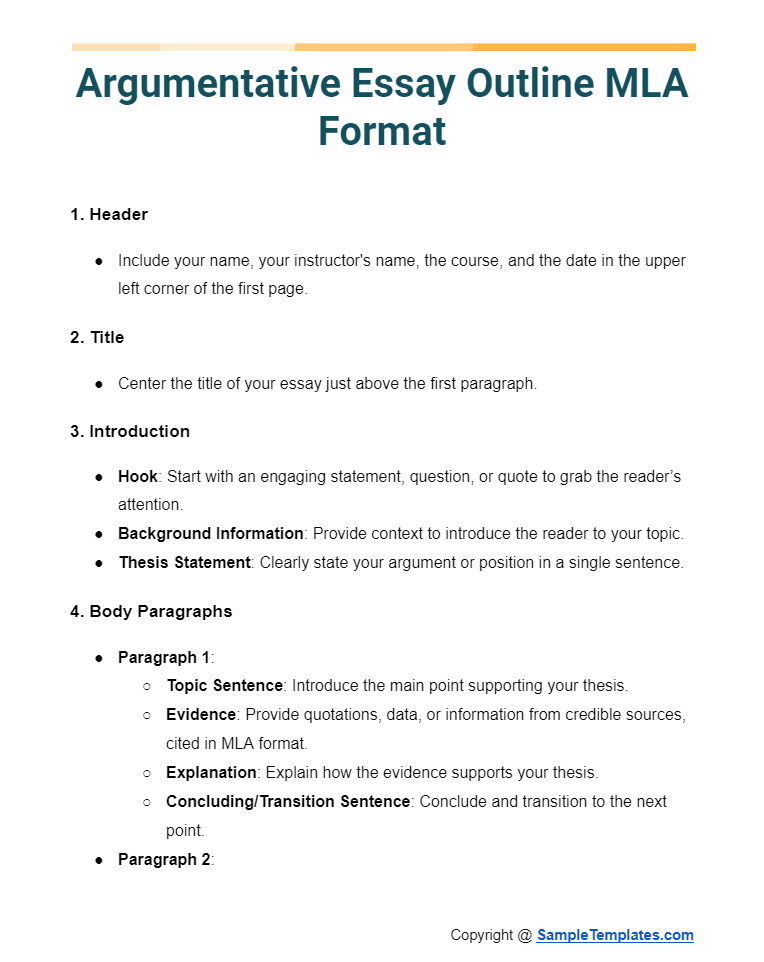
Argumentative Essay Outline Generator
- Introduction
- Hook: Start with a compelling sentence to grab the reader’s attention.
- Background Information: Briefly introduce the topic of the essay.
- Thesis Statement: Clearly state your position on the topic.
- Body Paragraphs
- Paragraph 1
- Topic Sentence: Introduce the main idea of the paragraph.
- Argument: Present your argument or point of view.
- Evidence: Support your argument with facts, data, or quotes.
- Explanation: Explain how the evidence supports your argument.
- Concluding Sentence: Wrap up the paragraph by reinforcing your argument and linking to the next point.
- Paragraph 2
- (Repeat the same structure as the first body paragraph)
- Paragraph 3
- (Repeat the same structure as the first body paragraph, consider presenting a counterargument here and refute it)
- Paragraph 1
- Conclusion
- Restate Thesis: Reaffirm your thesis statement, considering the arguments made.
- Summary of Main Points: Briefly summarize the main arguments made in the body paragraphs.
- Closing Remark: End with a strong statement, question, or call to action that encourages further thought or action on the topic.
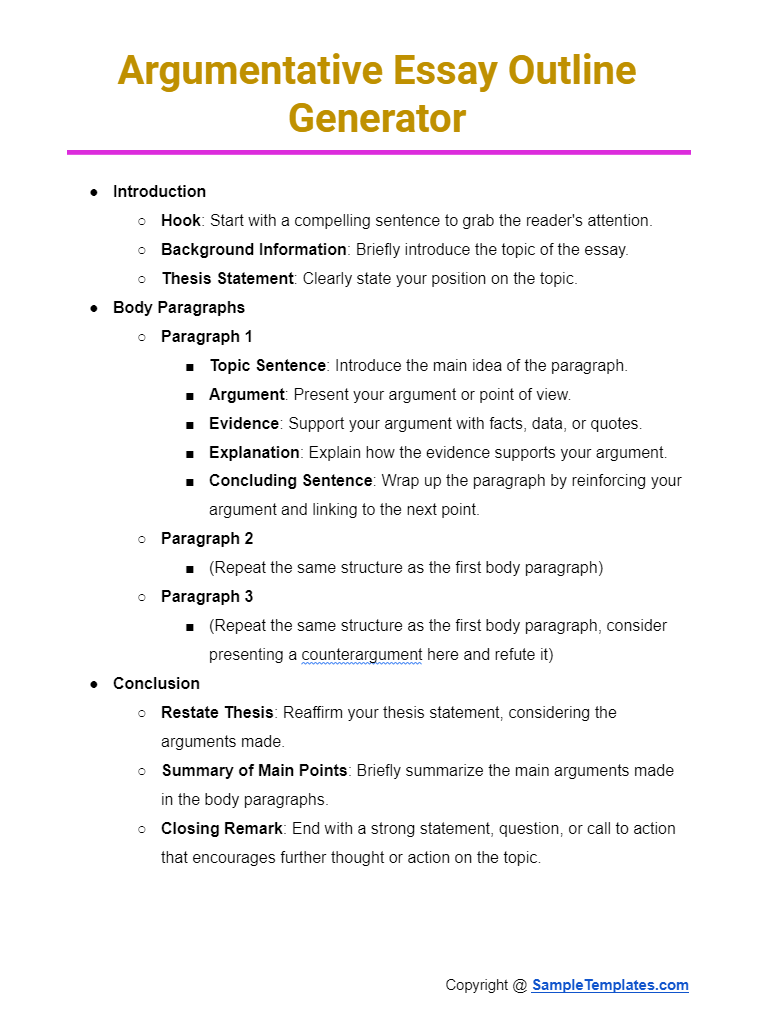
Browse More Templates On Argumentative Essay Outline
1. Argumentative Essay Outline Template
2. Sample Argumentative Essay Outline
3. Basic Analytical Argumentative Essay Outline
How to Write an Argumentative Essay Outline?
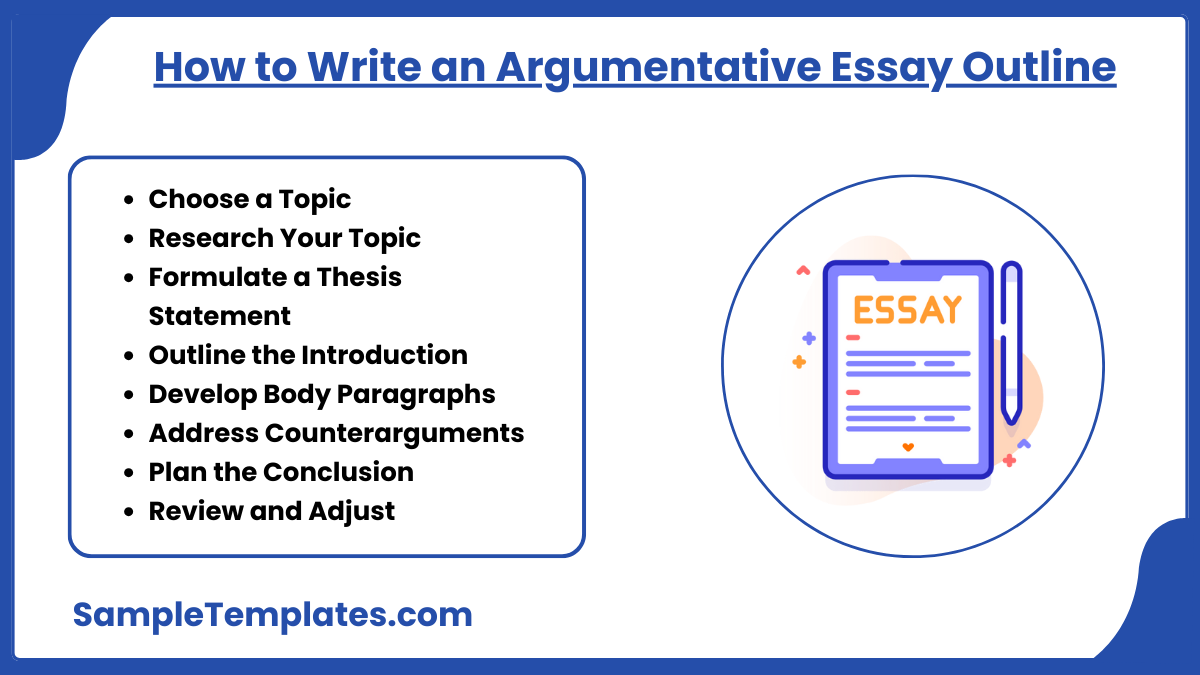
- Choose a Topic: Select a debatable topic that has at least two opposing perspectives.
- Research Your Topic: Gather credible sources to understand various viewpoints and gather evidence.
- Formulate a Thesis Statement: Clearly state your position on the topic in one sentence, indicating your main argument. You can also see more on Essay Structure.
- Outline the Introduction: Start with a hook to engage the reader, provide some background on the topic, and end with your thesis statement.
- Develop Body Paragraphs: Each paragraph should focus on a single point. Start with a topic sentence, add arguments and evidence to support your views, and provide a brief explanation of how the evidence connects to your argument.
- Address Counterarguments: Consider and refute opposing viewpoints in one or more paragraphs to strengthen your position. You can also see more on Outline Essay.
- Plan the Conclusion: Summarize your main points and restate your thesis in a reinforced way, showing how the evidence supports your arguments. Conclude with a strong closing statement that might suggest further implications or actions.
- Review and Adjust: Revisit your outline to ensure it’s logically structured and all points clearly support your thesis. Adjust as necessary to maintain a strong, coherent argument throughout the essay.
4. Claim Argumentative Essay Outline
5. Abortion Argumentative Essay Outline
What are the three 3 key components of an argumentative essay?
- Introduction with a Thesis Statement
- The introduction serves as the opening of your essay, setting the stage for the discussion. It should start with a hook to capture the reader’s attention, provide background information to set context, and conclude with a clear thesis statement. The thesis statement is crucial as it presents the main argument or claim of the essay, around which the entire argument is structured.
- Body Paragraphs with Supporting Evidence
- The body of an argumentative essay is where the main arguments in support of the thesis are developed. Each paragraph should focus on a specific aspect of the thesis, starting with a topic sentence that states the point clearly. This is followed by evidence and examples, which could be statistics, quotes, studies, or real-life examples. These pieces of evidence should be well-cited from credible sources. Moreover, a strong argumentative essay also addresses counterarguments, demonstrating why the opposing views are less valid or effective. You can also see more on Research Essay Outline.
- Conclusion
- The conclusion of an argumentative essay should reinforce the thesis statement and the arguments presented. It summarizes the key points made in the body paragraphs without introducing new information. Ideally, it should also provide a closing thought or call to action, encouraging the reader to think further about the issue, change their opinion, or take some action related to the topic discussed.
These components work together to make an argumentative essay persuasive and logically sound, ensuring that the reader can understand and be influenced by the author’s point of view.
6. Argumentative Essay Outline Example
7. Argumentative Essay Outline Format
8. Argumentative Opinion Essay Outline
9. Argumentative Essay Outline in PDF
Tips for Writing a Argumentative Essay Outline
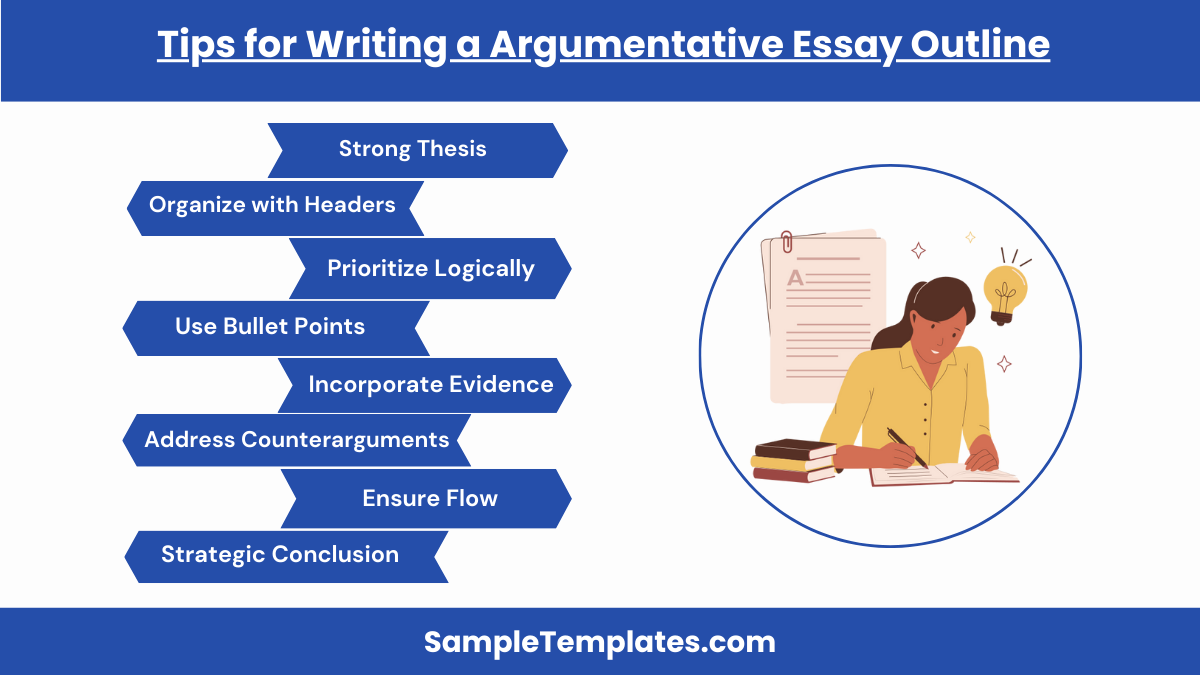
- Start with a Strong Thesis: Your thesis is the backbone of your essay. Ensure it is specific, debatable, and clear. It should state your position unequivocally and guide the development of your argument.
- Organize with Headers: Use clear headers for each section of your essay — introduction, body paragraphs, counterarguments, and conclusion. This helps in structuring your thoughts and keeping your argument focused. You can also see more on Essay Plan.
- Prioritize Points Logically: Arrange your main points in a logical order. Typically, you should present your strongest arguments first, but consider the narrative flow and how each point builds upon the previous one.
- Use Point Form: In your outline, bullet points can help organize information efficiently. For each point, jot down the main idea, the supporting evidence, and a brief explanation of how this evidence supports your claim.
- Incorporate Evidence: Outline where you will introduce specific pieces of evidence. Include key facts, quotes, statistics, or real-life examples. Specify the source for each piece of evidence to ensure credibility and ease of reference during later writing.
- Plan for Counterarguments: Decide where and how you will address opposing viewpoints. Include a brief summary of each counterargument and your rebuttal. Showing the ability to critically evaluate opposing views strengthens your own argument. You can also see more on Student Essay.
- Connect the Dots: Make sure each point logically flows to the next. Use transition words or phrases in your outline to denote connections between paragraphs, enhancing the coherence of your essay.
- Conclude Strategically: Plan your conclusion to restate your thesis and summarize your main points. Your outline should also include a powerful closing statement or call to action that leaves a lasting impression on the reader.
10. Printable Argumentative Essay Outline
11. Standard Argumentative Essay Outline
What is an Argumentative Essay Outline?
An argumentative essay outline is a type of essay writing that requires solid and reliable sources from which the writer or student can collect their information or data. Writing an argumentative essay outline means you are picking a side, defending it, and consistently invalidating the viewpoints that contradict your side of the argument. The more logical, well-written, and comprehensive you write your argumentative essay, the more you can convince your audience of the accuracy of your outline essay.
FAQs
What elements must an argumentative essay outline include?
The elements that are included in an argumentative essay outline are a clear, concise, and defined thesis statement in the first paragraph of the essay, clear and logical transitions between paragraphs, body paragraphs with evidential support, and a conclusion that highlights the evidence provided by the author. You can also see more on Essay Organizer.
What is the common method for writing an argumentative essay?
A common method to write an argumentative essay is called the five-paragraph essay approach which consists of an introductory paragraph, three body paragraphs, and a conclusion.
How should I research for my argumentative essay?
Researching for your essay includes a number of steps which start with the selection of the side you want to represent, picking an argument that will appeal to your audience, identifying other writers who support the same argument, determining the possible objections of your readers, and organizing the pieces of evidence you have collected. You can also see more on Persuasive Essay.
An argumentative essay outline is a type of academic writing in which the student who writes the essay chooses a side of the argument and supports it with pieces of evidence they have collected through interviews, surveys, and research. This type of writing only uses fact and logic to support the argument of the writer and effectively persuades the reader to acknowledge the accuracy and reliability of the overall argument.
Related Posts
FREE 10+ Sample Analysis Essay Templates in MS Word PDF
FREE 9+ Sample Essay Templates in MS Word PDF
FREE 8+ Persuasive Essay Samples in MS Word PDF
FREE 8+ Essay Samples in MS Word PDF
FREE 8+ Sample Expository Essay Templates in MS Word PDF
FREE 8+ Persuasive Essay Samples in MS Word PDF
FREE 7+ Sample College Essay Templates in MS Word PDF
FREE 7+ Academic Essay Samples in MS Word PDF
FREE 7+ Sample Student Essay Templates in MS Word PDF
FREE Persuasive Speech Examples in PDF MS Word
FREE 11+ Essay Writing Samples & Templates in PDF
FREE 11+ Professional Writing Samples in PDF MS Word
FREE 10+ Sample Thesis Statement Templates in MS Word PDF
FREE 9+ Sample Personal Essay Templates in MS Word PDF
FREE 8+ Response Essay Samples in MS Word PDF
